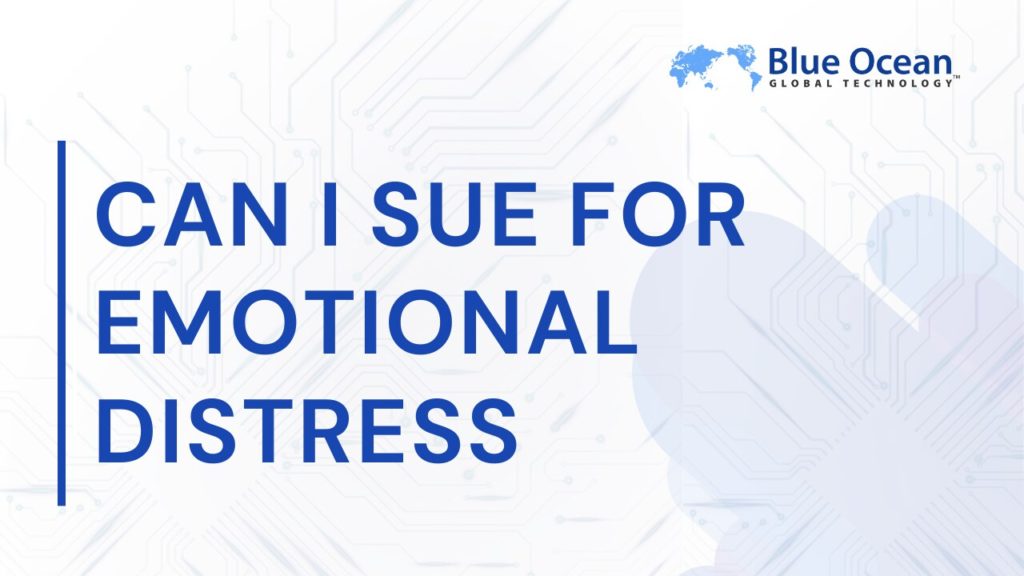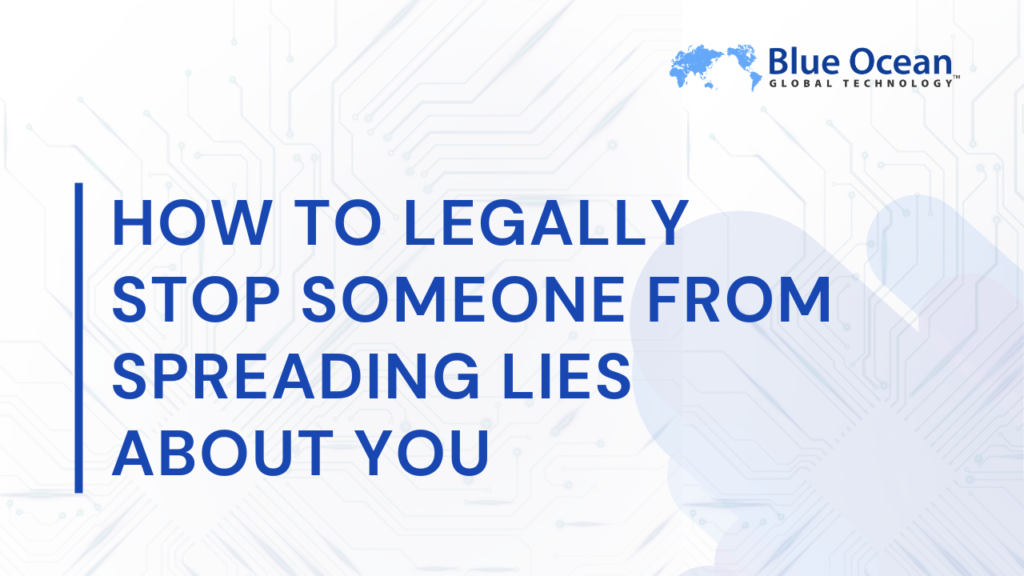Emotional distress is a profound psychological response to traumatic or stressful events that can severely disrupt daily life, relationships, and mental health. Often misunderstood and stigmatized, emotional distress manifests both mentally and physically, presenting unique challenges in diagnosis and treatment. A crucial but underexplored intersection exists between medical care and the legal recognition of emotional suffering, which can help ensure comprehensive support for affected individuals.

Picture Credits: Freepik
This guide explains emotional distress, including its symptoms, causes, coping mechanisms, and professional help options. We also detail how this condition is addressed in legal contexts, such as lawsuits for intentional or negligent infliction of emotional distress, and provide actionable advice for navigating legal claims alongside therapeutic care. Blue Ocean Global Technology offers resources to connect individuals with legal support systems for meaningful recovery.
What is Emotional Distress?
Emotional distress refers to significant psychological anguish that arises from experiences such as trauma, harassment, or the loss of a loved one. This state can trigger various physical and emotional reactions, often requiring medical evaluation and care.
What Does Emotional Distress Mean in Psychological Terms?
Mental health professionals define emotional distress as a response to extreme stress, frequently linked to psychological trauma. Psychological trauma, such as exposure to violence, accidents, or abuse, often exacerbates emotional distress by disrupting a person’s ability to process or cope with difficult situations.
Emotional distress can co-occur with mental health conditions, including anxiety disorders, depression, and post-traumatic stress disorder (PTSD), complicating diagnosis and treatment plans.
Physical Symptoms of Emotional Distress: What Are Somatic Symptoms?
Emotional distress often has a physical dimension known as somatic symptoms, which manifest as bodily complaints linked to psychological pain.
- Emotional distress may cause headaches, gastrointestinal discomfort, or muscle tension.
- Somatic symptoms and related disorders develop when physical symptoms persist, even in the absence of medical explanations.
- Treatments for somatic issues include therapy, stress management practices, and addressing the underlying psychological triggers.
Why Is Emotional Distress Often Misunderstood?
Emotional distress is frequently misinterpreted due to societal barriers and a lack of awareness about mental health. Many individuals fail to recognize psychological suffering, confusing it with emotional weakness rather than a valid health concern.
Stigmatization of mental health conditions further deters people from seeking help or acknowledging their distress, leaving symptoms untreated and potentially worsening their outcomes. Shifting societal attitudes and education programs are critical to improving recognition and support for those experiencing emotional distress.

Picture Credits: Freepik
Symptoms and Causes of Emotional Distress
Understanding the symptoms and causes of emotional distress allows for prompt intervention and alleviation of its effects. Addressing its root causes is essential for effective coping and resolution.
What Are the Symptoms of Emotional Distress?
Emotional distress manifests in ways that affect thought processes, behavior, and the body.
- Behavioral symptoms may include irritability, withdrawal from social interactions, or outbursts of anger.
- Emotional indicators can range from persistent sadness or guilt to feelings of overwhelming anxiety.
- Somatic symptoms, such as fatigue or digestive issues, are physical expressions of emotional suffering and can complicate diagnosis without proper evaluation.
Risk Factors for Emotional Distress: Who Is More Vulnerable?
Certain individuals face greater risks of developing emotional distress due to personal or environmental factors, including:
- Experiencing long-term stress caused by high-pressure work environments or financial difficulties.
- Living through unstable home conditions or exposure to cultural, socio-economic, or systemic discrimination.
- Personal history of trauma or chronic medical conditions heightening emotional vulnerability.
What Causes Emotional Distress?
Emotional distress stems from internal and external stressors that overwhelm the individual.
- Traumatic experiences, including the loss of a loved one or surviving catastrophic disasters, are common triggers.
- Conflicts in personal relationships or toxic interactions can contribute to emotional discord.
- Chronic health issues, both physical and mental, frequently invoke psychological distress, underscoring the importance of whole-body care.

Picture Credits: Freepik
Coping with Emotional Distress and When to Seek Help
Managing emotional distress effectively requires proactive steps, from personal coping mechanisms to engaging professional assistance when needed.
How to Cope With Emotional Distress
Individuals managing emotional distress can turn to several techniques that reduce its impact and restore equilibrium:
- Self-calming strategies like mindfulness meditation and deep-breathing exercises.
- Digital platforms such as Calm and BetterHelp provide tools for immediate stress relief and remote therapy.
- Journaling or creating art to process complex emotions and cultivate emotional clarity.
According to a 2023 study in the Journal of Mental Health, teletherapy has significantly reduced barriers to accessing mental health support, highlighting its growing importance in the modern care landscape.
When Should You Seek Professional Support?
Some signs indicate that emotional distress requires professional intervention. Persistent or escalating symptoms that disrupt daily life—such as extreme anxiety, insomnia, or thoughts of self-harm—warrant immediate action.
Mental health professionals use various diagnostic tools to evaluate emotional distress, often combining psychotherapy, medication, and lifestyle interventions to achieve long-term recovery.
Practical Tips for Day-to-Day Management
Daily habits can play a powerful role in mitigating emotional distress:
- Maintain connections with friends, family, or mentors for emotional support.
- Use mindfulness tools like journaling to record feelings in a constructive outlet.
- Prioritize regular physical activity, which provides therapeutic effects through endorphin release.

Picture Credits: Freepik
Legal Aspects of Emotional Distress
Emotional distress is not solely a medical or mental health issue—it also has legal dimensions when caused by another party’s negligent or intentional action.
Can Emotional Distress Be Grounds for a Lawsuit?
Emotional distress qualifies as a basis for legal claims under these circumstances:
- Intentional infliction of emotional distress occurs when a party’s extreme or outrageous conduct deliberately causes harm.
- Negligent infliction of emotional distress happens when harm arises through careless actions, without malicious intent.
What Are the Key Elements of an Emotional Distress Claim?
Establishing liability in emotional distress cases requires demonstrating:
- Proof of the defendant’s negligence or intentional misconduct.
- Verification of intense emotional pain meeting the “severe suffering” legal standard.
- A specific causal linkage between the accused’s actions and the plaintiff’s distress.
Need Legal Help for Emotional Distress?
Connect with our team to discuss your situation and potential legal remedies
Evidence Used to Prove Emotional Distress
Documentation plays a critical role in legal claims:
- Psychologists’ reports and treatment notes provide objective evidence of emotional suffering.
- Personal records such as journals, combined with corroborating eyewitness accounts, illustrate the larger impact.
A 2024 legal journal emphasized that cases supported by therapist-patient records often achieve higher success rates in court rulings.
Damages and Compensation in Emotional Distress Cases
Courts may award the following damages in emotional distress lawsuits:
- Economic damages to cover the costs of counseling or lost wages.
- Non-economic damages for the pain and suffering endured.
- Punitive damages penalizing particularly egregious misconduct.

Picture Credits: Freepik
Special Topics on Emotional Distress Lawsuits
Complex legal situations surrounding emotional distress claims benefit from thorough preparation.
Proving Emotional Distress: Key Challenges and Examples
Success in such claims poses challenges, especially in the absence of physical injuries. However, cases where clear documentation, such as therapist assessments, supplements legal arguments have set precedents for favorable outcomes.
Limits and Barriers to Emotional Distress Claims
Lawsuits based on emotional harm may encounter limitations such as statutes of limitations, which vary by jurisdiction, and strict evidentiary requirements that can make such claims harder to prove.
Integrating Medical Care and Legal Steps
Combining therapeutic care with legal strategy results in more robust claims. Collaborative approaches involving psychologists’ testimony enable courts to connect the legal claim with professionally validated emotional injuries.

Picture Credits: Freepik
Additional Resources and FAQs on Emotional Distress
Frequently asked questions
1. Can you sue for emotional distress without physical harm?
Yes, but the claim may be harder to prove without accompanying physical injuries.
2. What is the standard for intentional infliction of emotional distress?
The conduct must be extreme, outrageous, and deliberately intended to cause severe harm.
3. How can legal and therapeutic teams work collaboratively?
Lawyers and therapists can align documentation and expert testimony to strengthen claims.
Useful tools and references for emotional distress cases
- Headspace and Sanvello: Apps tailored to stress reduction and emotional resilience.
- Online legal platforms to assist in filing personal injury or emotional distress claims.
Resources for legal and medical support
- Organizations such as the National Alliance on Mental Illness (NAMI) offer support hotlines.
- Local government websites provide guidance on claims processes tailored to state-level laws.
Conclusion
Understanding emotional distress involves addressing its psychological, medical, and legal implications. Key takeaways include recognizing symptoms early, seeking proper care, and documenting evidence for legal claims. Blue Ocean Global Technology specializes in bridging these areas to offer individuals comprehensive support.
Struggling with Emotional Distress?
Discover how to cope and take legal action with expert guidance from Blue Ocean Global Technology.













Comments are closed.